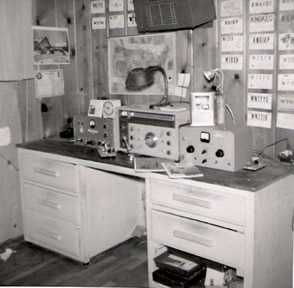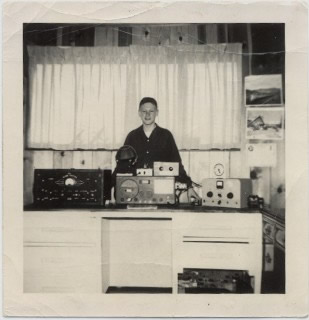History of W7YTZ
I like working DX and receiving QSL cards from around the world. I currently have worked 235 countries and have received 224 DX entities' QSL cards. My XYL, KD7VJQ, has been very active in managing the QSL cards. This is a big job and I have much respect for those DX stations who deal in thousands of cards per year. I use ProLog for electronic logging. It shows just over 4,000 contacts since I started using it in 1999. That's not a large amount, but most all contacts are DX entities. I have my original paper logs dating back to 1955. They total 14 log books and some day I hope to enter all of those contacts into the electronic log system. The awards I have received are: WAS WAC WAC DXCC WAE WAP RCC. My total countries worked are 231 Mixed and 216 Phone. I find it harder all the time to get new countries. |
 After using the Hallicrafters S-40B, I advanced to an SX-28 receiver. What a difference that was. To the left is a WRL Globe trotter, using a single 807 with a modulator but no VFO. It only ran 35 watts and I did not use it very much. The Heathkit AT-1 was still my main use transmitter on 3714 Khz. The PR crystal is still in the shack today over 50 years later. After using the Hallicrafters S-40B, I advanced to an SX-28 receiver. What a difference that was. To the left is a WRL Globe trotter, using a single 807 with a modulator but no VFO. It only ran 35 watts and I did not use it very much. The Heathkit AT-1 was still my main use transmitter on 3714 Khz. The PR crystal is still in the shack today over 50 years later. |
 Then National came out with their NC300 receiver and I had just got my General license. I purchased the Globe Scout from WRL and a Turner 80X microphone. The Heathkit AT-1 was still in the shack and soon I would help my best friend, Bob Hays, as he became Wn7ZYK. I sold the AT-1 to Bob and he enjoyed its use during his novice career. QSL cards started popping up on the wall and I felt like I was finally a "true" Ham! Note the SX-28 speaker on the wall above the NC300. I used that for several years. Then National came out with their NC300 receiver and I had just got my General license. I purchased the Globe Scout from WRL and a Turner 80X microphone. The Heathkit AT-1 was still in the shack and soon I would help my best friend, Bob Hays, as he became Wn7ZYK. I sold the AT-1 to Bob and he enjoyed its use during his novice career. QSL cards started popping up on the wall and I felt like I was finally a "true" Ham! Note the SX-28 speaker on the wall above the NC300. I used that for several years. |
 I sold the Globe Scout and acquired a Lysco transmitter with VFO and an external modulator. This picture was taken during field day, 1957, on Hawks Prairie near Olympia. The Lysco was a great little rig, but didn't have a lot of power, only about 40 watts. I was beginning to dream of higher power by then, but was enjoying working as many stations as I could, especially DX. I sold the Globe Scout and acquired a Lysco transmitter with VFO and an external modulator. This picture was taken during field day, 1957, on Hawks Prairie near Olympia. The Lysco was a great little rig, but didn't have a lot of power, only about 40 watts. I was beginning to dream of higher power by then, but was enjoying working as many stations as I could, especially DX. |
.jpg) The Heathkit DX100 was the next big addition to the shack in 1958. My signal improved a lot with a pair of 6146 in the final running 180 watts input and weighing in at 102 pounds. The AM modulation transformers and power supply transformers were not light. At the time, I did not know that two years later I would haul my station to Alaska up the Alcan highway some 2,000 miles and become KL7DQU. The Heathkit DX100 was the next big addition to the shack in 1958. My signal improved a lot with a pair of 6146 in the final running 180 watts input and weighing in at 102 pounds. The AM modulation transformers and power supply transformers were not light. At the time, I did not know that two years later I would haul my station to Alaska up the Alcan highway some 2,000 miles and become KL7DQU. |
 My original QSL card from 1955. My original QSL card from 1955. |
NEXT PAGE
 In 1955, at the age of fourteen, I received my license as Wn7YTZ in Olympia, Washington. Those early days were great! The picture below shows my first station, a Heathkit AT-1 and Hallicrafters S40B receiver. Also in the picture is a rather rare WRL Globe Trotter. In 1957, the sun spot cycle was at its peak and was phenomenal. Working DX on 10 meters worldwide, using 60 watts and a 3 element beam was the highlight of my early years. After high school, I joined the US Army Alaska Communications System and was sent to Lena Point, Alaska (near Juneau). After three years, I returned to Washington and worked (except for two years at COMSAT) for the Washington State Patrol Electronic Services Division. I retired as Assistant Commander in 1991. I then worked for Raytheon for seven years, doing jobs for the Federal Aviation Administration as a contractor. We installed equipment all over the country. One of my projects was to build eight mobile air traffic control towers in specially built 5th wheel trailers. They have been used extensively around the United States for special purposes. In 2000, I went to work for the Washington State Department of Transportation as an Electronic Design Engineer on Microwave Communications systems. As of May, 2008 I finally retired for the last time and will be enjoying travel and "Hamming."
In 1955, at the age of fourteen, I received my license as Wn7YTZ in Olympia, Washington. Those early days were great! The picture below shows my first station, a Heathkit AT-1 and Hallicrafters S40B receiver. Also in the picture is a rather rare WRL Globe Trotter. In 1957, the sun spot cycle was at its peak and was phenomenal. Working DX on 10 meters worldwide, using 60 watts and a 3 element beam was the highlight of my early years. After high school, I joined the US Army Alaska Communications System and was sent to Lena Point, Alaska (near Juneau). After three years, I returned to Washington and worked (except for two years at COMSAT) for the Washington State Patrol Electronic Services Division. I retired as Assistant Commander in 1991. I then worked for Raytheon for seven years, doing jobs for the Federal Aviation Administration as a contractor. We installed equipment all over the country. One of my projects was to build eight mobile air traffic control towers in specially built 5th wheel trailers. They have been used extensively around the United States for special purposes. In 2000, I went to work for the Washington State Department of Transportation as an Electronic Design Engineer on Microwave Communications systems. As of May, 2008 I finally retired for the last time and will be enjoying travel and "Hamming."